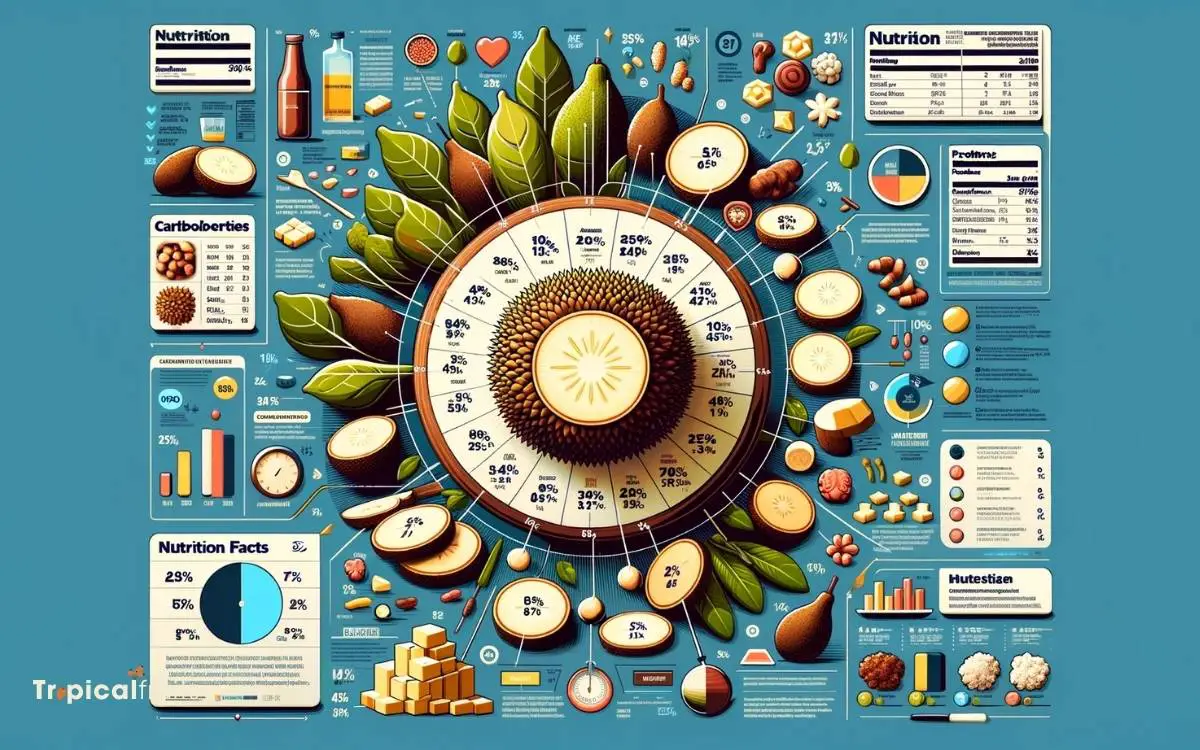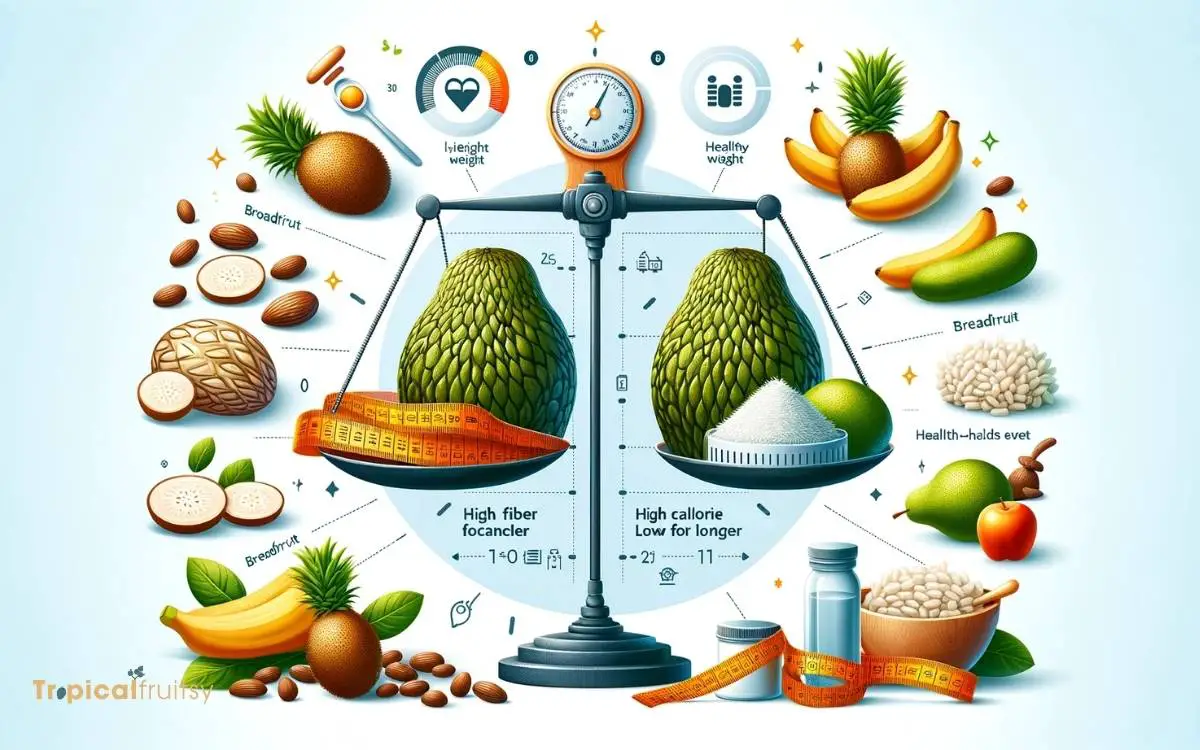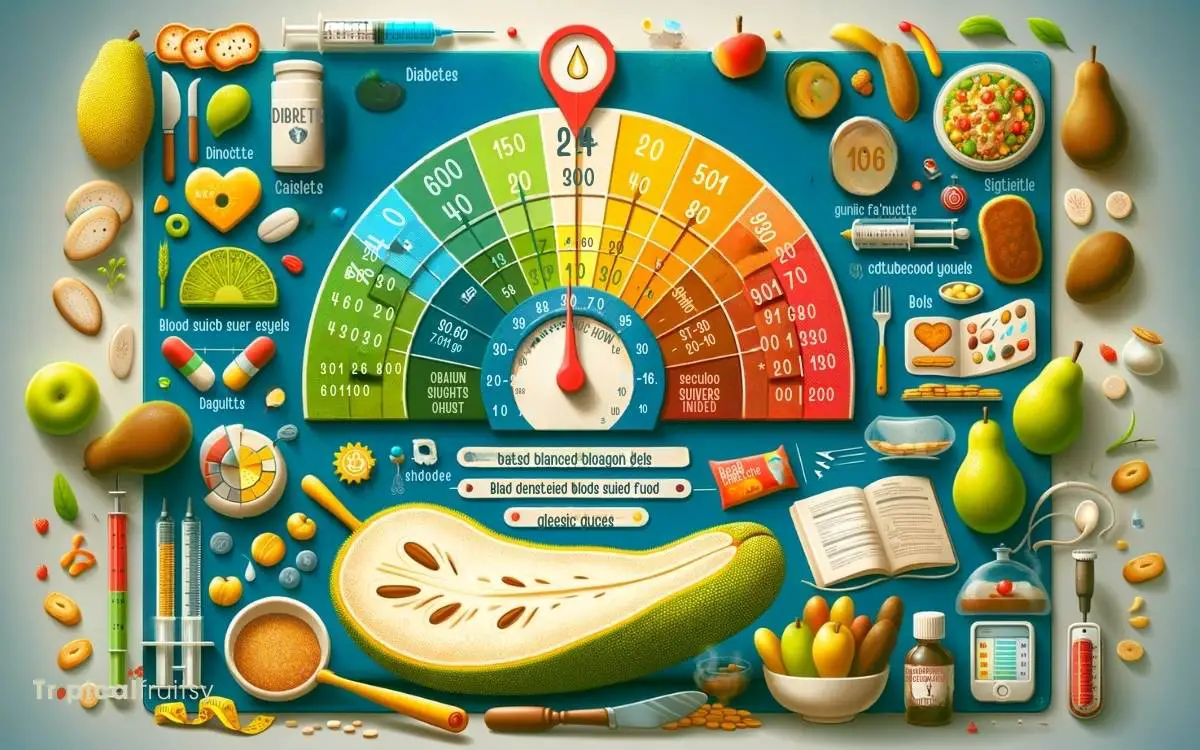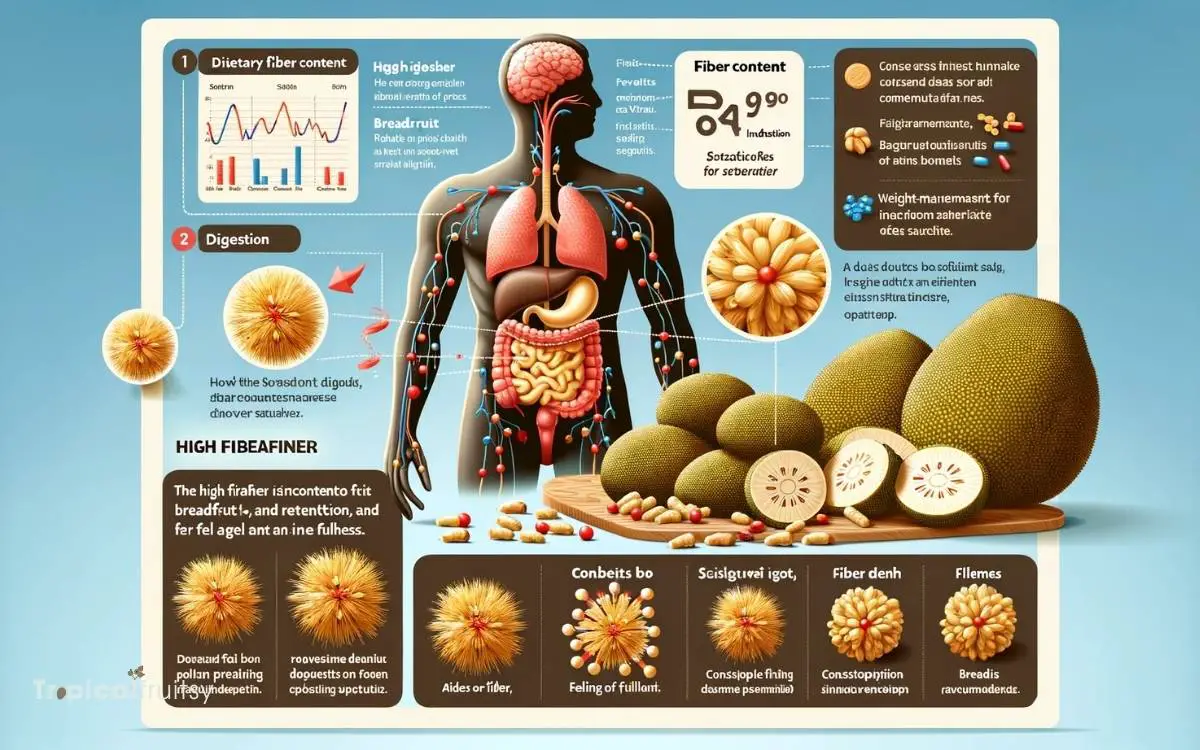Is Breadfruit Good for You? Unveiling the Health Benefit!
Breadfruit is indeed beneficial for health. This nutrient-dense tropical fruit is packed with vitamins, minerals, fiber, and antioxidants, which contribute to its heart-healthy properties.
It’s low in cholesterol and saturated fat, and its moderate glycemic index makes it suitable for those with diabetes.
Its fiber content promotes digestive health and helps with weight management. Including breadfruit in your diet can enhance your overall nutrition and provide protective health benefits.
Breadfruit is a nutrient powerhouse with multiple health benefits:
For example, incorporating breadfruit into a meal as a substitute for potatoes offers a lower glycemic alternative.
Discover the wholesome benefits of breadfruit—a nutritious choice for a healthier diet and lifestyle.

Key Takeaway
9 Health Benefits of Breadfruit
| Health Benefit | Description |
|---|---|
| Nutrient-Rich | Breadfruit is a good source of carbohydrates, dietary fiber, vitamins, and minerals, such as potassium and magnesium. |
| Low in Fat and Cholesterol | It is naturally low in fat and cholesterol, making it a heart-healthy option. |
| Provides Dietary Fiber | The dietary fiber in breadfruit can aid in digestion and promote a feeling of fullness. |
| Rich in Potassium | Potassium in breadfruit may help maintain healthy blood pressure levels. |
| May Boost Immunity | It contains vitamins and antioxidants that support the immune system. |
| Potential Antioxidant Properties | Certain compounds in breadfruit have antioxidant properties that can protect cells from damage. |
| May Aid in Weight Management | The fiber content can help control appetite and support weight management. |
| Gluten-Free | Breadfruit is naturally gluten-free, making it suitable for those with gluten sensitivities. |
| Versatile Ingredient | It can be used in various culinary dishes, offering versatility in meal preparation. |
Nutritional Breakdown of Breadfruit

In examining the nutritional composition of breadfruit, it is evident that this tropical staple is a rich source of vitamins, minerals, and dietary fiber.
It contains notable amounts of vitamin C, which is vital for immune function and skin health, as well as thiamine, riboflavin, and niacin, which are essential B vitamins important for energy metabolism.
Breadfruit is also a good source of potassium, essential for maintaining electrolyte balance and normal muscle and nerve function.
Additionally, it provides magnesium, which plays a role in over 300 enzymatic reactions in the body, including those involved in energy production and DNA synthesis.
The presence of dietary fiber in breadfruit supports digestive health and may contribute to the feeling of fullness, which can aid in weight management.
Heart Health Benefits

Bearing in mind the nutritional profile of breadfruit, its high fiber and potassium content are particularly beneficial for heart health, reducing the risk of cardiovascular disease by aiding in the regulation of blood pressure and cholesterol levels.
Dietary fiber is known to help lower blood cholesterol by binding with cholesterol particles and removing them from the body. Potassium, on the other hand, helps to relax blood vessel walls and maintain proper blood pressure.
| Nutrient | Heart Health Benefit |
|---|---|
| Fiber | Lowers cholesterol |
| Potassium | Regulates blood pressure |
| Antioxidants | Prevents oxidative stress |
| Vitamin C | Strengthens blood vessel walls |
| Magnesium | Supports heart muscle function |
These heart-friendly attributes make breadfruit a valuable addition to a heart-healthy diet.
Breadfruit’s Role in Weight Management

Breadfruit’s potential impact on weight management can be considered by examining its caloric content relative to other staple foods.
Its capacity to promote satiety, due in part to its fiber content, may help regulate appetite and reduce overall calorie intake.
Including breadfruit as part of a fiber-rich diet could be beneficial for those seeking to manage their weight while ensuring nutritional adequacy.
Caloric Content Comparison
How does the caloric content of breadfruit compare to other staple foods, and what implications does this have for weight management?
Breadfruit has a relatively low caloric density when compared to other staples like rice or pasta, making it a beneficial option for those looking to manage their weight.
Its high fiber content also contributes to a feeling of fullness, which can help prevent overeating.
Caloric content of breadfruit compared to other staples:
- Rice: A cup of cooked white rice contains about 200 calories, while an equivalent amount of breadfruit has approximately 227 calories but with a higher fiber content.
- Pasta: Standard cooked pasta has about 220 calories per cup, whereas breadfruit offers more micronutrients and fiber for a similar caloric count.
Understanding the caloric and nutritional content of breadfruit can guide individuals in making informed dietary choices for weight management and overall health.
Satiety and Fullness Factor
The fiber-rich composition of breadfruit contributes significantly to its ability to promote satiety and assist in weight management by providing a feeling of fullness with fewer calories.
Dietary fiber, which is abundant in breadfruit, has been recognized for its role in regulating the digestive system and prolonging satiation.
This can lead to a natural reduction in calorie intake, as individuals may feel satisfied for longer periods after consuming fiber-rich foods like breadfruit.
Clinical studies have shown that high-fiber diets are associated with lower body weight and reduced risk of obesity.
Breadfruit’s fiber content, alongside its nutrient-dense profile, makes it a beneficial food for those looking to maintain or achieve a healthy weight without sacrificing nutritional quality.
Fiber-Rich Diet Inclusion
Incorporating breadfruit into one’s diet, with its considerable fiber content, can be an effective strategy for weight management and control.
As a nutrient-dense, low-energy food, breadfruit offers a dual approach to weight management:
High Dietary Fiber:
- Promotes satiety: Fiber-rich foods like breadfruit can help in feeling full for longer periods, reducing the tendency to overeat.
- Supports digestive health: A healthy digestive system is crucial for maintaining a healthy weight.
The fiber in breadfruit not only aids in digestive regularity but also plays a role in stabilizing blood sugar levels, which is important for preventing cravings and managing hunger.
Including breadfruit as part of a balanced diet can contribute to a healthy weight management plan.
Glycemic Index and Diabetes

Regarding the management of diabetes, the glycemic index (GI) of breadfruit is a significant factor to consider when assessing its suitability as part of a diabetic diet.
The GI measures how quickly a food can raise blood glucose levels. Foods with a lower GI are generally more suitable for managing diabetes as they lead to a slower, more controlled rise in blood sugar levels.
| Quality | Low GI Foods | High GI Foods |
|---|---|---|
| Impact | Slower rise in glucose | Rapid rise in glucose |
| GI Range | 55 or less | 70 or more |
| Example | Breadfruit | White bread |
Breadfruit falls into the low GI category, making it a potentially good choice for diabetics. Understanding the GI of foods can contribute to better blood sugar control.
Dietary Fiber Content Explained

Breadfruit is a notable source of dietary fiber, a critical component for maintaining digestive health.
The fiber content in breadfruit contributes to a range of health benefits, including improved bowel regularity and aiding in the prevention of constipation.
Current dietary guidelines recommend a daily intake of fiber, which varies based on age and gender, and incorporating breadfruit into one’s diet can help meet these recommendations.
Fiber Benefits
Among the numerous health benefits of breadfruit, its high dietary fiber content stands out as particularly advantageous for digestive health.
Dietary fiber, which is indigestible by human enzymes, plays a crucial role in maintaining a healthy gut.
Here’s how:
Promotion of Gut Health
- Prebiotic Effect: Fiber acts as a food source for beneficial gut bacteria, promoting a balanced microbiome.
- Regular Bowel Movements: The bulk-forming quality of fiber helps to prevent constipation and normalize bowel movements.
Incorporating breadfruit into one’s diet can contribute to the recommended daily intake of fiber, which is 25 grams for women and 38 grams for men according to the Institute of Medicine.
This makes breadfruit not only a nutritious but also a functionally beneficial food choice.
Digestive Health Impact
While the previous section highlighted the general benefits of dietary fiber, it is essential to delve into how the specific fiber content in breadfruit impacts digestive health.
| Nutrient | Content in Breadfruit |
|---|---|
| Dietary Fiber | High |
| Soluble Fiber | Present |
| Insoluble Fiber | Abundant |
Breadfruit is rich in dietary fiber, which facilitates bowel regularity and helps prevent constipation. The presence of soluble fiber aids in the modulation of blood glucose levels and the reduction of cholesterol.
Insoluble fiber adds bulk to the stool and can help food pass more quickly through the stomach and intestines. This balance of fibers makes breadfruit an excellent food for maintaining a healthy digestive system.
Daily Intake Recommendation
How does the fiber content in breadfruit align with the recommended daily intake for dietary fiber?
A single cup of breadfruit provides approximately 4.9 grams of fiber, which is a significant contribution towards the daily recommendations of 25 grams for women and 38 grams for men, as suggested by the Institute of Medicine.
Dietary Fiber Recommendations:
- Women: 25 grams per day
- Men: 38 grams per day
Including breadfruit as part of a balanced diet can help in meeting these fiber goals, supporting digestive health and contributing to a feeling of fullness.
Powerhouse of Antioxidants

Breadfruit is an exceptional source of various antioxidants, which we need to combat oxidative stress and bolster our immune systems.
These naturally occurring compounds are vital in protecting cells from damage caused by free radicals, which can lead to chronic health issues like heart disease and cancer.
Research has identified a range of antioxidants in breadfruit, including flavonoids, phenols, and vitamin C. Each of these plays a role in neutralizing harmful molecules and supporting overall health.
The presence of these antioxidants in breadfruit not only contributes to its potential health benefits but also emphasizes its value as part of a balanced diet.
Including breadfruit in one’s diet could, therefore, be a strategic way to enhance the body’s defense system against oxidative stress.
Breadfruit in Traditional Diets

Incorporated into traditional diets across the Pacific Islands, breadfruit serves as a staple food with significant cultural and nutritional importance.
This versatile fruit is not only a source of essential nutrients but also holds a place in the cultural fabric of these communities.
Traditional Uses:
- Staple Food: Often compared to other starchy staples like potatoes, its versatility allows for various preparations, including boiling, frying, and baking.
- Cultural Significance: Breadfruit is celebrated in folklore and rituals, symbolizing sustenance and connection to the land.
The consumption of breadfruit in these regions is not merely a matter of sustenance but encompasses a broader context of tradition and community.
Its prominence in diets reflects a reliance on indigenous food systems that are sustainable and naturally adapted to the local environment.
What are the health benefits of using breadfruit in cooking and recipes?
Discover the health benefits of using breadfruit in cooking and recipes with a comprehensive breadfruit usage guide. Packed with essential nutrients like fiber, potassium, and vitamins, breadfruit can help improve digestion, lower blood pressure, and boost immunity. Enjoy its versatility in various dishes for a tasty and nutritious meal.
How to Incorporate Breadfruit Into Meals

Transitioning from its traditional role in Pacific Islander diets, breadfruit can be seamlessly integrated into modern meals as a nutritious substitute for starchy staples like potatoes and rice.
Its versatile nature allows it to be used in a variety of dishes. When ripe, its sweetness lends itself to desserts and baked goods.
Unripe breadfruit has a potato-like texture, making it ideal for boiling, frying, or mashing. It can be incorporated into soups, stews, and curries, or sliced thinly to make nutritious chips.
Breadfruit flour, made by grinding dried breadfruit, is a gluten-free alternative for baking, providing a high-fiber option for breads, pancakes, and pastries.
Introducing breadfruit into your diet can enhance culinary diversity and contribute to a balanced, healthful eating pattern.
Conclusion
Breadfruit emerges as a nutritious staple, endowed with a plethora of health benefits.
Its rich composition offers a symphony of dietary fiber, antioxidants, and vital nutrients that harmonize to support cardiovascular health, regulate weight, and stabilize glycemic levels.
When woven into the fabric of daily diets, breadfruit stands as a testament to traditional wisdom. Its versatility painting a canvas of culinary possibilities that nourish the body and cater to a holistic approach to well-being.






